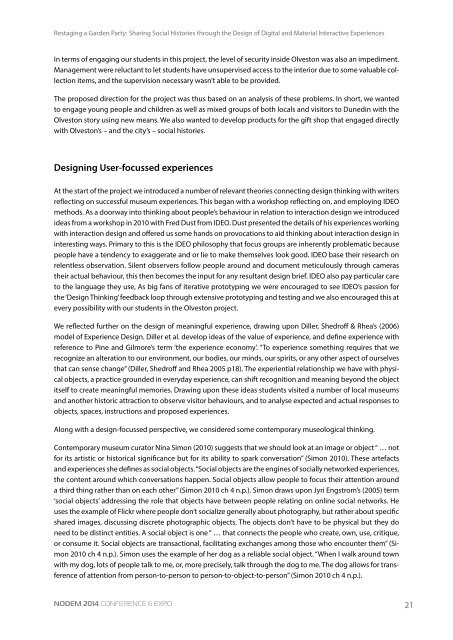NODEM 2014 Proceedings
NODEM 2014 Proceedings
NODEM 2014 Proceedings
You also want an ePaper? Increase the reach of your titles
YUMPU automatically turns print PDFs into web optimized ePapers that Google loves.
Restaging a Garden Party: Sharing Social Histories through the Design of Digital and Material Interactive Experiences<br />
In terms of engaging our students in this project, the level of security inside Olveston was also an impediment.<br />
Management were reluctant to let students have unsupervised access to the interior due to some valuable collection<br />
items, and the supervision necessary wasn’t able to be provided.<br />
The proposed direction for the project was thus based on an analysis of these problems. In short, we wanted<br />
to engage young people and children as well as mixed groups of both locals and visitors to Dunedin with the<br />
Olveston story using new means. We also wanted to develop products for the gift shop that engaged directly<br />
with Olveston’s – and the city’s – social histories.<br />
Designing User-focussed experiences<br />
At the start of the project we introduced a number of relevant theories connecting design thinking with writers<br />
reflecting on successful museum experiences. This began with a workshop reflecting on, and employing IDEO<br />
methods. As a doorway into thinking about people’s behaviour in relation to interaction design we introduced<br />
ideas from a workshop in 2010 with Fred Dust from IDEO. Dust presented the details of his experiences working<br />
with interaction design and offered us some hands on provocations to aid thinking about interaction design in<br />
interesting ways. Primary to this is the IDEO philosophy that focus groups are inherently problematic because<br />
people have a tendency to exaggerate and or lie to make themselves look good. IDEO base their research on<br />
relentless observation. Silent observers follow people around and document meticulously through cameras<br />
their actual behaviour, this then becomes the input for any resultant design brief. IDEO also pay particular care<br />
to the language they use, As big fans of iterative prototyping we were encouraged to see IDEO’s passion for<br />
the ‘Design Thinking’ feedback loop through extensive prototyping and testing and we also encouraged this at<br />
every possibility with our students in the Olveston project.<br />
We reflected further on the design of meaningful experience, drawing upon Diller, Shedroff & Rhea’s (2006)<br />
model of Experience Design. Diller et al. develop ideas of the value of experience, and define experience with<br />
reference to Pine and Gilmore’s term ‘the experience economy’. “To experience something requires that we<br />
recognize an alteration to our environment, our bodies, our minds, our spirits, or any other aspect of ourselves<br />
that can sense change” (Diller, Shedroff and Rhea 2005 p18). The experiential relationship we have with physical<br />
objects, a practice grounded in everyday experience, can shift recognition and meaning beyond the object<br />
itself to create meaningful memories. Drawing upon these ideas students visited a number of local museums<br />
and another historic attraction to observe visitor behaviours, and to analyse expected and actual responses to<br />
objects, spaces, instructions and proposed experiences.<br />
Along with a design-focussed perspective, we considered some contemporary museological thinking.<br />
Contemporary museum curator Nina Simon (2010) suggests that we should look at an image or object “ … not<br />
for its artistic or historical significance but for its ability to spark conversation” (Simon 2010). These artefacts<br />
and experiences she defines as social objects. “Social objects are the engines of socially networked experiences,<br />
the content around which conversations happen. Social objects allow people to focus their attention around<br />
a third thing rather than on each other” (Simon 2010 ch 4 n.p.). Simon draws upon Jyri Engstrom’s (2005) term<br />
‘social objects’ addressing the role that objects have between people relating on online social networks. He<br />
uses the example of Flickr where people don’t socialize generally about photography, but rather about specific<br />
shared images, discussing discrete photographic objects. The objects don’t have to be physical but they do<br />
need to be distinct entities. A social object is one “ … that connects the people who create, own, use, critique,<br />
or consume it. Social objects are transactional, facilitating exchanges among those who encounter them” (Simon<br />
2010 ch 4 n.p.). Simon uses the example of her dog as a reliable social object. “When I walk around town<br />
with my dog, lots of people talk to me, or, more precisely, talk through the dog to me. The dog allows for transference<br />
of attention from person-to-person to person-to-object-to-person” (Simon 2010 ch 4 n.p.).<br />
<strong>NODEM</strong> <strong>2014</strong> Conference & Expo<br />
21


